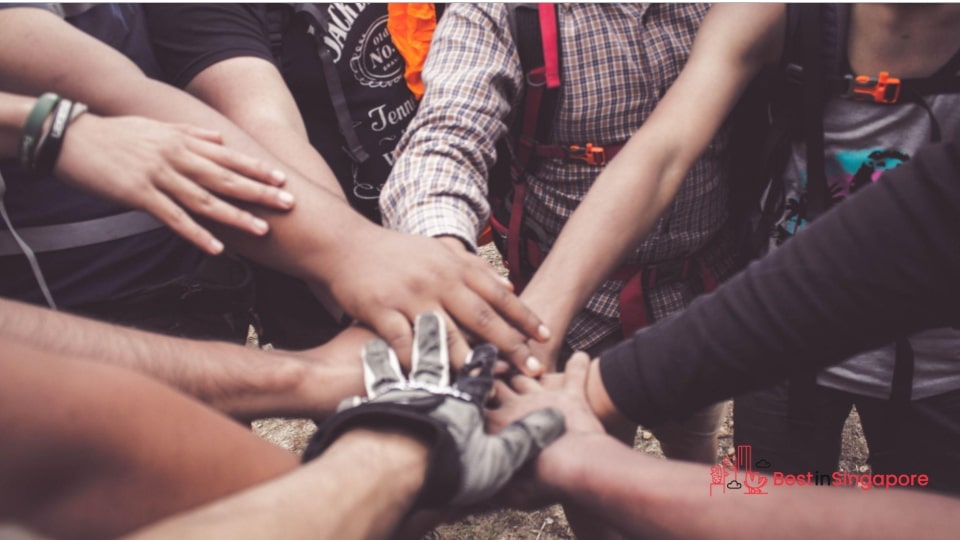What is the biggest challenge facing the youth of Singapore?
The question of why Singapore has many unhappy people has been raised time and time again. In particular, plenty of young Singaporeans seem to consider themselves either mentally struggling (according to a 2022 TODAY Youth Survey).
In this post, we’ll take a closer look at the crucial challenges faced by Singaporean youth, from academic pressure and soaring costs to demands from personal relationships. We’ll also discuss what can be done to address them.
Pressure to Achieve Academic Excellence

Why are Singaporeans competitive? For starters, the education system in Singapore is highly competitive, so it’s a trait established at a tender age.
Unsurprisingly, one of the significant challenges facing the youth in Singapore is the pressure to excel academically. There’s often a heavy emphasis on grades and academic achievements, too.
Singapore also has a limited number of spaces available in local universities compared to the number of students graduating from secondary schools.
— From m.amrulkhair
This competitive university admission process adds to the pressure as students strive to secure a place in their desired courses. In turn, this pressure can lead to stress, anxiety, and a lack of work-life balance among students.
So how can the youth and their guardians/mentors address this crisis?
Students must communicate their challenges to trusted individuals, seek support, and develop effective study strategies and time management skills.
As for support persons and groups, it’s good to note that each student’s situation is unique. That’s why it’s important to find the support system and resources that best fit their needs.
Local community centres and youth organisations, such as Care Corner and REACH, often provide resources and programmes to support students academically and emotionally.
Rising Cost of Housing

Another challenge faced by Singaporean youth is that adequate housing is becoming harder to afford. Singapore is notorious for having a high cost of living, with housing prices steadily increasing as the years go by.
Additionally, Singapore has limited land resources, resulting in high property prices and rental rates. Many young people aspire to own or rent their own homes, but the steep costs make it challenging to achieve this goal.
— From jacquikyl
This has made it more difficult for young people to afford even the most basic apartments. It can also affect their long-term financial stability and prospects.
But there’s a glimmer of hope. The Singaporean government has implemented various measures to address the cost of living concerns and provide financial assistance to low-income individuals and families.
Nonetheless, the cost of living remains a significant concern for many Singaporean youth as they plan for their futures.
Youth can explore the option of coliving spaces and sharing a rental flat with roommates or friends to split the cost.
Bullying and Peer Pressure

In 2015, Singapore youth experienced the third-highest bullying rate in the entire world, according to a study by the Organisation for Economic Cooperation and Development (OECD). And it’s not just in the realms of physical or verbal bullying but online, as well.
Cyberbullying uses digital platforms like social media, messaging apps, or online forums to harass, intimidate, or spread harmful content about someone.
And in our guide to social media statistics in Singapore, it’s found that 3 in 4 teens have experienced cyberbullying at some point.
— From nycsg
Another form of bullying involves social exclusion which deliberately isolates an individual from social groups, spreading rumours, or manipulating social relationships to undermine a person’s social standing or friendships.
The experiences of bullying can vary greatly among individuals, and there may be additional forms that I haven’t mentioned here.
Fortunately, the Singaporean government, educational institutions, and various organisations have taken steps to address bullying and promote anti-bullying initiatives, creating safe and inclusive environments for youth.
The Samaritans of Singapore (0966-351-4518) and the Tinkle Friend (1800 2744 788) helplines can offer support and guidance for individuals facing cyberbullying.
Family Issues

An alarming 2014 report from the Samaritans of Singapore revealed that family relationship issues were the primary problems brought forth by suicidal Singaporean youth. And the issues vary from one family to another, too.
Singapore has experienced significant societal and cultural changes over the years, leading to a generation gap between parents and youth. Differences in values, beliefs, and perspectives can create misunderstandings and conflicts within the family.
Also, many parents in Singapore have demanding work schedules. This can result in limited quality time and reduced emotional connection between the youth and their parents.
Additionally, Singapore has seen a shift in family structures, including an increase in single-parent households, divorced or separated parents, or families with dual working parents.
— From yylee_familylaw
Addressing family issues requires open and effective communication, empathy, and understanding between family members.
Families must also create a supportive and nurturing environment where youth feel safe to express themselves, seek help when needed, and develop healthy relationships with their parents and siblings.
Families in conflict can seek family counselling to address their issues before they escalate.
Relationship with Romantic Partner

Many young Singaporeans often have idealised expectations of romantic relationships dictated by societal norms, media portrayals, or peer pressure. And it doesn’t help that a lot of influencers they look up to show unrealistic relationship standards.
When reality doesn’t meet these expectations, it can lead to disappointment, frustration, or a sense of inadequacy.
Moreover, Singapore is a multicultural society, and the youth may encounter challenges when navigating romantic relationships involving different cultural backgrounds or religious beliefs.
New values, traditions, and family expectations can create conflicts and strain in the relationship.
— From iwtyouconfidence
Singaporean youth may also face parental influence and involvement in their romantic relationships, especially when it comes to dating choices or decisions about the future.
Unfortunately, some youth may also experience forms of relationship abuse, including emotional, verbal, or physical abuse, in their romantic relationships. It’s crucial for youth to recognize signs of abuse and seek help to ensure their safety and well-being.
Websites such as ReachOut Singapore and Family Central offer articles, tools, and advice on relationship issues.
Sexual Violence and Harassment

Sexual violence is a distressing issue that affects the lives of many young people in Singapore. Unfortunately, the Singapore Police Force reported that molestation cases increased by 514% from 21 in 2021 to 129 in 2022.
Sadly, only a small percentage have sought help when faced with sexual molestation or violence.
Sexual violence can manifest in various forms, including sexual assault, rape, sexual harassment, and exploitation. It can occur within relationships, among peers, or in other settings such as schools, social gatherings, dates, or online platforms.
— From asurvivorsvoice_
Thankfully, the Singaporean government, along with various organisations and agencies, has been working to raise awareness about sexual violence, provide support to survivors, and implement preventive measures.
Additional efforts have also been made to educate youth about consent, healthy relationships, and the importance of reporting incidents of sexual violence. If you or someone you know is a victim of sexual violence, it’s crucial to seek help and support.
The Sexual Assault Care Centre (SACC) in Singapore provides specialised medical, counselling, and legal services for survivors of sexual assault.
Mental Health Issues

General anxiety and other issues have steadily contributed to Singaporean youth facing various mental health challenges through the years.
Anxiety disorders, like generalized anxiety disorder (GAD), social anxiety disorder, and panic disorder, can affect their mental well-being.
— From redwood_psychology
Depression is a common mental health issue among youth in Singapore, as well. Some youth may also engage in self-harming behaviours or experience suicidal thoughts due to overwhelming emotional distress and other above-mentioned factors.
But as bleak as things may seem, there’s help to be had.
For one, the Singaporean government has been working to increase awareness, reduce stigma, and improve access to mental health services for youth. Many organisations and healthcare providers mirror these services.
And there are reliable psychotherapy services should professional help be required. Early identification, intervention, and access to mental health support services are crucial in effectively addressing these challenges.
The Singapore Association for Mental Health’s YouthReach can lend a helping hand to young individuals (aged 12 to 21) who are facing emotional, psychological, and psychiatric challenges in the community.
Everyday Expenses

Singaporean youth may find various daily expenses challenging to manage, depending on their individual circumstances. Aside from housing costs, there are other anxiety-inducing fees that need to be faced (and paid).
- Transportation fees – The cost of transportation, including public transportation fares, private car ownership, or ride-sharing services, can add up. This is particularly true for youth who need to commute to work, school, or social activities regularly.
- Food and dining costs – The cost of food and dining out can be a considerable expense for Singaporean youth. Eating out or ordering food delivery frequently can strain their budget, especially if they opt for more expensive options or have dietary restrictions.
- Education expenses – Education-related costs, including tuition fees, textbooks, school supplies, and extracurricular activities, can be a challenge for youth pursuing higher education or attending specialised courses.
- Personal care and health bills – Health-related expenses, such as medical consultations, medications, health insurance premiums, and personal care products, can be a financial strain for youth, especially if they have specific health needs or chronic conditions.
- Internet fees – The cost of mobile phone plans, Internet subscriptions, and data usage can be significant for youth who rely heavily on technology for communication, education, and entertainment purposes.
- Recreational costs – Participating in social activities, entertainment events, hobbies, or recreational pursuits can incur expenses, especially if they involve ticket fees, membership costs, or equipment rentals.
To help offset school fees, explore options like the MOE Financial Assistance Scheme, SkillsFuture Study Awards, or scholarships offered by universities and educational institutions.
What are effective ways to address the biggest challenges of Singapore’s youth?
Addressing the biggest challenges faced by Singapore’s youth requires a multi-faceted approach. It will be long-term, but the results will be worth it.
There’s also a need to involve various stakeholders, including the government, educational institutions, community organizations, families, and the individuals themselves.
1. Educational Reforms
— From moesingapore
While Singapore already has an admirable educational system in place, there’s still some room for improvement which can help the youth overcome particular challenges.
For instance, continuously reviewing and adapting the education system can help reduce excessive academic pressure and foster holistic development.
It may also be a good idea to place emphasis on skills such as critical thinking, problem-solving, creativity, and emotional intelligence alongside academic achievements.
2. Mental Health Support
— From annabellepsychology
No ifs and buts about it—there needs to be an increase in awareness and accessibility of mental health services in schools and community centres. It should get to the point that seeking help for mental health issues becomes a knee-jerk reaction.
Providing counselling services, workshops, and resources can help youth cope with stress, anxiety, and other concerns. At the same time, there should be an increase in awareness, a reduction in stigma, and improved access to mental health services
3. Financial Literacy Education
— From voicesglobalcollective
Integrating financial literacy education into the school curriculum can help equip youth with essential financial management skills. It’s never too early to get them started.
At home, parents can start teaching budgeting, saving, and responsible spending to empower young people in managing their finances effectively. They can also help their kids manage their allowance and pocket money wisely.
4. Affordable Housing Solutions
— From cloud_nnoon
By increasing the availability of affordable housing options for youth, there will be a better chance for them to have decent shelter and a place to call their own. This is particularly helpful to those with limited financial resources.
Private groups and the government can also help the youth explore initiatives such as subsidised rental schemes, shared living arrangements, and affordable homeownership programs.
5. Community Engagement
— From yosephinputeri
Community centres and youth organisations can encourage youth participation in community service, volunteerism, and leadership programs. Engaging them shows how important their role is in the entire community.
These activities also promote a sense of belonging, social responsibility, and personal development.
6. Anti-Bullying Measures
— From antibullying.sg
It’s important to implement comprehensive anti-bullying policies in schools, workplaces, and online platforms. Only then can bullying in any form be squashed before it even starts.
Other ways to help bullying victims can include conducting awareness campaigns, providing counselling services, and encouraging reporting to address and prevent bullying and cyberbullying incidents.
7. Promoting Work-Life Balance

When a culture of work-life balance by promoting flexible work arrangements is encouraged, it helps take the anxiety off school and future work arrangements. In turn, it can pave the way for happier, more industrious students and workers.
This can be done by promoting leisure and recreational activities and reducing excessive working hours. Doing so also helps the youth maintain a healthy balance between their personal and professional lives.
8. Skills Development Programmes

Various institutions and businesses can offer vocational training programs, apprenticeships, and internships to provide practical skills and enhance the employability of the youth.
It can show them that other options are available for their future careers.
The collaboration between educational institutions and industries can bridge the gap between education and the job market, as well.
9. Strengthening of Support Networks

Establishing support networks involving parents, teachers, mentors, and community leaders can provide guidance and mentorship to youth.
It can hopefully encourage open communication and active listening and create a supportive environment.


